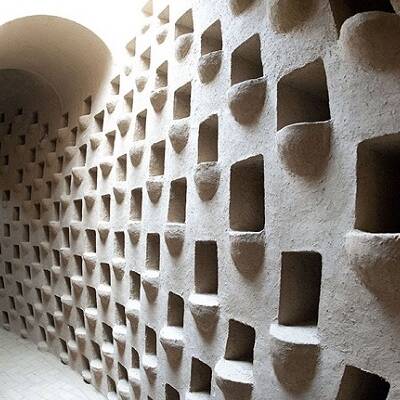Located in the heart of the desert, Meybaod can be found sixty kilometers north of Yazd Province. It is an ancient city long known for its pottery. Its history can be proved by Narin Qal’eh, a castle that traces back to third millennium B.C.
During the Islamic era, Meybod was a lively city, and it has been mentioned in history books by Hamdillah Mostofi and Sharaf al-Din Ali Yazdi, both famous scholars. But the city flourished during the eighth century AH, when it was one of the headquarter of elders of Muzaffarids. Although they later moved to Yazd and Kerman, Meybod continued its social, cultural, and political life which can be seen in the monuments that remain there. They include caravanserai and Yakhchal from the Safavid dynasty, a Chapar Khaneh from Qajar, and an architecture that parallels with the buildings of Yazd.
Meybod Chapar Khaneh is reminiscent of the Qajar era. It was built by Mirza Mohammad Ali Yazdi. It is a rare sample of its kind that still remains today. Although its function has changed – it is now a post office – but it has been repaired during a ten-year period by the supports from the Monuments Lovers Association of Meybod and the Cultural Heritage, Handicrafts and Tourism Organization of Iran.
Meybod Chapar Khaneh was a post office during the rule of Qajar. Royal letters and parcels were sent to the capital and other cities from this post. Since important orders and parcels were temporarily stored there, guarding towers and barracks were later built to protect the chapar khaneh and the people who lived there. It is mostly made from raw cob bricks and clay. Bricks have been used only in the portal, roof and the feet of the walls in the yard. The building has a central yard, and the stables have been built all over it. It has two roofed spaces that were used as resting areas of the horses, the riders, the guards, and the commanders.
The replica of the chapar khaneh in its original form can be seen in one of the rooms that has turned into a museum. The history of post and telegraph has also been presented in the museum. There are replicas of the horses, the stamps, historical documents to old telegraph instruments and telephones to be visited.
In ancient Iran, horse riding postal service was developed to deliver messages and parcels in the shortest possible time. The horses needed to ride long distances. Therefore, chapar khaneh or buildings designed for resting and keeping of the horses were built along the paths. The messengers left their tired horses to rest there and continued their journeys with newly rested horses. This system was developed during the Achaemenid Empire and lived on for centuries until the modern post service entered Iran. Now, these chapar khanehs have turned into monuments.







